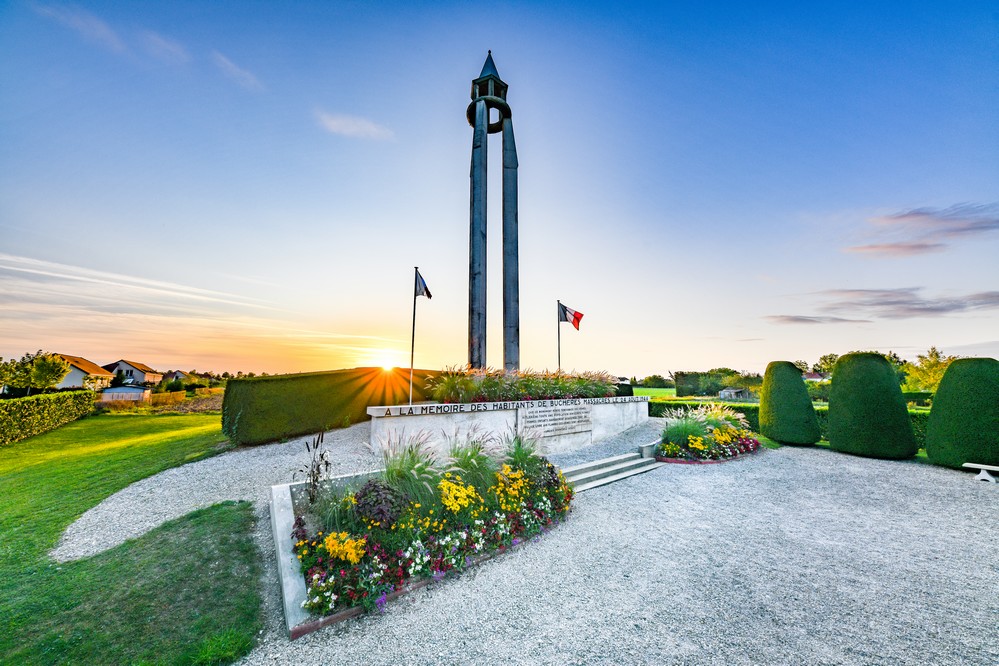Terror spread like wildfire in August 1944.
22 August: 49 prisoners, mostly members of the Resistance, were taken from their cells in the Troyes prison and killed with no trial at the Creney-près-Troyes shooting range. 23 August: 68 men, women and children were massacred and their homes burned down by the SS as revenge for the attack on a convoy. 25 August: 6 men and 1 woman were shot by the Nazis in La Rivière-de-Corps. 27 August: 13 hostages were executed by the Afrika Korps in Montreuil-sur-Barse. 28 August: 80 residents of Mesnil-Saint-Père were killed… Unfortunately, the overwhelming litany of martyrdom in the Aube area is not limited to these dates or places. A land of resistance, the Aube area paid a high price for their bravery during the Second World War.
Scattered in and around Troyes, countless plaques and monuments ensure the memory of these atrocities lives on. The more moving of them attempt to put a face on the victims.

In Creney-près-Troyes, the monument was erected some distance from the homes in a ‘zone of silence’ at the end of an avenue lined by 53 trees, representing the number of victims that fell here (four patriots on 22 February 1944).
The agony is depicted by a man kneeling, almost naked, hands behind his back with his head to one side in a Christ-like pose.
The whiteness of the stele seems to have discoloured the surrounding paths and fields.
Above Laines-aux-Bois, set aside from the village, stands an elegant monument to the memory of the ‘quatre de Montaigu’.
Despite its name, it bears the names of 27 resistance-fighters of the Libération-Nord network killed during the war. There is a maquis scene engraved on the base which leads to a stairway. Four men stand in a square, their hands behind their backs, their chests pushed out, awaiting their execution with male pride.
A tricolour flag floats at each corner of the pedestal, beaten by the winds from the Champagne plains, where the town of Troyes can be seen in the distance.
The Mémorial de Buchères, which features no human figures, stands out for its sober style: a tall arrow thrown high in the sky, vertically bearing the names of the horrific number of victims of this massacre…but can abomination be measured with a number? — Oradour-sur-Glane.

The Monument de la Résistance et de la Déportation in Troyes is the most massive and impressive of all, even nostalgic of works of the Soviet period.
It seems to want to convey the immutable power of memory when men refuse to forget. The fifteen-metre-long wall is decorated with a frieze featuring many symbols – apparently inspired by Picasso’s Guernica – and a group of statues, where a member of the Resistance stands, his fists clenched. At his feet lies a deportee.
These monumental sculptures can also be interpreted as illustrations of life and death. Below the standing man, the following inscription is engraved:
« Médite et souviens-toi. » “Reflect and remember”.
There are no names engraved in the stone, making this a universal tribute to victims
The complete text of the Appeal of 18 June is shown on a plaque. The monument can be seen from the entrance to the town centre, opposite the Argence fountain.
The town of Troyes itself was relatively spared by the bombings. It only bears one small but significant scar from the Second World War: the impacts of bullets which are still visible on the facade of the building located at no.45 rue Emile-Zola.
They are reminders of the fire used by American soldiers, 26 August 1944, to root the Germans out of the building which had been converted into military barracks.
